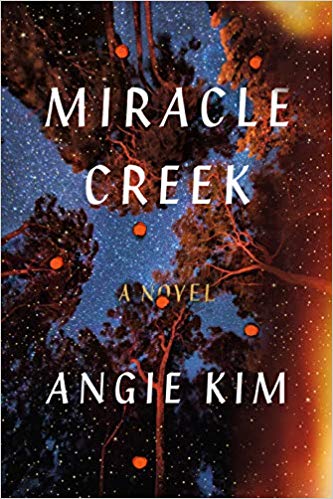Miracle Creek: A Novel
- By Angie Kim
- Sarah Crichton Books
- 368 pp.
- Reviewed by Drew Gallagher
- April 19, 2019
This clever, emotional courtroom drama pushes the boundaries of the whodunit genre.

My reading of the whodunit genre is far from exhaustive, but I believe author Angie Kim has created a narrative arc in her debut novel, Miracle Creek, that is unique in the annals of mystery.
Stop me if you’ve heard this plot before: Matt, a young, attractive physician with a possible fetish for Asian women, has low sperm motility that his Asian, impossibly driven wife, Janine, determines must have a root cause and a solution. Janine convinces herself that the cure for Matt’s slow swimmers rests in hyperbaric oxygenation.
As luck would have it, Janine has a Korean-immigrant friend who recently opened a hyperbaric oxygenation (HBOT) facility nearby in Northern Virginia which Janine happens to have a financial stake in.
The facility, dubbed “Miracle Submarine,” and its pure oxygen treatments are also believed to cure autism. Matt’s “dives” (the term used to denote the gradual elevating of oxygen inside enclosed chambers at the facility) include a number of children with autism.
During one of the dives, a fire is set on an exterior wall of the facility. When it ignites the oxygen in the chambers, the building burns quickly, with the occupants still inside. Three are killed, and others, including Matt, are maimed.
The structure of Miracle Creek derives from the subsequent trial tied to the murder charges leveled against the mother of one of the children killed in the incident. Author Kim, an attorney by trade, does the courtroom drama exceptionally well.
She brings more nuance to the proceedings than the 15 minutes allotted in a typical “Law and Order” episode, but manages the police-procedural effect by casting doubt on the assumptions readers made just a few pages earlier. I’m not familiar with how Kim fared as an attorney, but she appears to be a capable weaver of intrigue.
Though it may be cliché, the numerous characters are seemingly all suspects, with assorted motivations, and many don’t appreciate the necessity for truth. Unfortunately, lying under oath doesn’t seem to give them much pause, either.
Given the author’s legal background, the fictional proceedings cast worrisome doubt on due process and justice in real life (assuming actual witnesses lie as often as they do here). Of course, it’s a much duller and shorter book if everything goes as the prosecutor has scripted, and the defendant reaches a plea agreement in chapter two.
This is not to say that Kim runs too far afield of the possible. As one character reflects, life is anything but predictable and can change with the flutter of a butterfly’s wing:
“But that was the way life worked. Every human being was the result of a million different factors mixing together — one of a million sperm arriving at the egg at exactly a certain time; even a millisecond off, and another entirely different person would result. Good things and bad — every friendship and romance formed, every accident, every illness — resulted from the conspiracy of hundreds of little things, in and of themselves inconsequential.”
Kim tells each chapter from the perspective of one of the main characters and intersperses the trial scenes with flashbacks and reflective passages on the difficulties of immigrating to the United States and how these disparate threads served as a fuse for the literal fire.
It’s clear that the dead and injured aren’t the accident’s only victims; this is not a story of redemption or rainbows.
There are two particular elements in the novel that I found compelling. One is the way Kim handles the protestors at Miracle Submarine (because there have to be protestors anytime parents are trying to improve the lives of their autistic children).
Every morning, the protestors arrive at the facility with signs and chants designed to intimidate and deride those participating in the procedures. The protestors don’t decry the medically unproven HBOT treatments. Rather, they proclaim the fact that we’re all God’s children and that attempting to change one of God’s creations, even to help a child, is blasphemy.
Obviously, if the protestors had autistic kids of their own, they wouldn’t have time to stand around haranguing those they neither know nor care to know.
The second memorable moment involves a scene with Matt and Mary — the latter the teenage daughter of the Korean owners of Miracle Submarine. The description of their encounter leaves the reader with a feeling of deep disgust only furthered at the novel’s conclusion.
To share the account, or even its nature, would do a disservice to a reader just coming to this book, but suffice it to say that eliciting such guttural revulsion is a literary accomplishment no matter how repulsive.
In the end, Miracle Creek proves to be not so much a whodunit as an existential reflection on the choices people make — or don’t make — and the ripples those choices send through others’ lives to miraculous, often devastating effect.
[Editor's note: Angie Kim will appear at this year's Gaithersburg Book Festival on May 18th in Olde Towne Gaithersburg, MD. Click here for a full schedule of events.]
Drew Gallagher is a freelance writer residing in Fredericksburg, VA.

